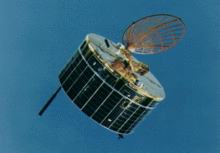Sakigake
Sakigake ( Japanese さ き が け , dt. "Harbinger") was a Japanese space probe that was launched in 1985 to explore Comet Halley .
mission
Sakigake , known as MS-T5 before launch , was Japan's first spacecraft. The 140 kg probe was equipped with three instruments, a magnetometer and two devices for measuring plasma waves and solar wind . She should be exploring Comet Halley.
course
- Sakigake was launched on January 8, 1985 with an MU-3 launcher from the Japanese space center in Kagoshima .
- The closest approach to Halley was on March 11, 1986. The distance was 7 million km. Thus, the probe could only be used for remote sensing of the comet. It is not known whether the probe was that far from Halley due to a navigation error or whether this was intentional. Sakigake also supported the European probe Giotto with its navigation.
- In 1987, commands were sent to the probe that put it on course to Earth .
- On January 8, 1992, July 14, 1993 and July 3, 1995, Sakigake performed a gravity-assist maneuver on earth. The probe was diverted to fly past the comets Honda-Mrkos-Pajdusakova (planned for February 3, 1996) and Giacobini-Zinner (planned for November 29, 1998).
- Shortly after the last gravity-assist maneuver, however, the exhaustion of fuel supplies was ascertained and the planned comet fly-bys were canceled.
- Contact with Sakigake was lost on November 15, 1995.
Results
Despite certain flaws, Japan's first probe mission was a success. Sakigake remained active for almost 11 years, significantly more than the 77 seconds of the first US probe Pioneer 0 or the 92 seconds of the first Soviet probe Luna 1958 A (see Lunik mission ). At least some scientific data of value could be obtained in interplanetary space, near Halley and in near-Earth space.
See also
Web links
- Sakigake in the NSSDCA Master Catalog (English)

